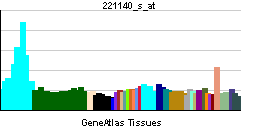GPR132
| G protein-coupled receptor 132 | |||||||||||
|---|---|---|---|---|---|---|---|---|---|---|---|
| Identifiers | |||||||||||
| Symbols | GPR132 ; G2A; MGC99642 | ||||||||||
| External IDs | Template:OMIM5 Template:MGI HomoloGene: 8350 | ||||||||||
| |||||||||||
| RNA expression pattern | |||||||||||
 | |||||||||||
| More reference expression data | |||||||||||
| Orthologs | |||||||||||
| Template:GNF Ortholog box | |||||||||||
| Species | Human | Mouse | |||||||||
| Entrez | n/a | n/a | |||||||||
| Ensembl | n/a | n/a | |||||||||
| UniProt | n/a | n/a | |||||||||
| RefSeq (mRNA) | n/a | n/a | |||||||||
| RefSeq (protein) | n/a | n/a | |||||||||
| Location (UCSC) | n/a | n/a | |||||||||
| PubMed search | n/a | n/a | |||||||||
G protein-coupled receptor 132, also known as GPR132, is a human gene.[1]
This gene encodes a subfamily member of the G-protein couple receptor (GPCR) superfamily. The encoded protein is a high-affinity receptor for lysophosphatidylcholine (LPC), a major phospholipid component of oxidized low density lipoprotein. This protein may react to LPC levels at sites of inflammation to limit the expansion of tissue-infiltrating cells. A similar protein in mouse is involved in cell cycle progression.[1]
References
Further reading
- Weng Z, Fluckiger AC, Nisitani S; et al. (1998). "A DNA damage and stress inducible G protein-coupled receptor blocks cells in G2/M". Proc. Natl. Acad. Sci. U.S.A. 95 (21): 12334–9. PMID 9770487.
- Kabarowski JH, Zhu K, Le LQ; et al. (2001). "Lysophosphatidylcholine as a ligand for the immunoregulatory receptor G2A". Science. 293 (5530): 702–5. doi:10.1126/science.1061781. PMID 11474113.
- Le LQ, Kabarowski JH, Wong S; et al. (2002). "Positron emission tomography imaging analysis of G2A as a negative modifier of lymphoid leukemogenesis initiated by the BCR-ABL oncogene". Cancer Cell. 1 (4): 381–91. PMID 12086852.
- Strausberg RL, Feingold EA, Grouse LH; et al. (2003). "Generation and initial analysis of more than 15,000 full-length human and mouse cDNA sequences". Proc. Natl. Acad. Sci. U.S.A. 99 (26): 16899–903. doi:10.1073/pnas.242603899. PMID 12477932.
- Rikitake Y, Hirata K, Yamashita T; et al. (2002). "Expression of G2A, a receptor for lysophosphatidylcholine, by macrophages in murine, rabbit, and human atherosclerotic plaques". Arterioscler. Thromb. Vasc. Biol. 22 (12): 2049–53. PMID 12482833.
- Lin P, Ye RD (2003). "The lysophospholipid receptor G2A activates a specific combination of G proteins and promotes apoptosis". J. Biol. Chem. 278 (16): 14379–86. doi:10.1074/jbc.M209101200. PMID 12586833.
- Lum H, Qiao J, Walter RJ; et al. (2003). "Inflammatory stress increases receptor for lysophosphatidylcholine in human microvascular endothelial cells". Am. J. Physiol. Heart Circ. Physiol. 285 (4): H1786–9. doi:10.1152/ajpheart.00359.2003. PMID 12805023.
- Murakami N, Yokomizo T, Okuno T, Shimizu T (2004). "G2A is a proton-sensing G-protein-coupled receptor antagonized by lysophosphatidylcholine". J. Biol. Chem. 279 (41): 42484–91. doi:10.1074/jbc.M406561200. PMID 15280385.
- Gerhard DS, Wagner L, Feingold EA; et al. (2004). "The status, quality, and expansion of the NIH full-length cDNA project: the Mammalian Gene Collection (MGC)". Genome Res. 14 (10B): 2121–7. doi:10.1101/gr.2596504. PMID 15489334.
- Witte ON, Kabarowski JH, Xu Y; et al. (2005). "Retraction". Science. 307 (5707): 206. doi:10.1126/science.307.5707.206b. PMID 15653487.
- Radu CG, Nijagal A, McLaughlin J; et al. (2005). "Differential proton sensitivity of related G protein-coupled receptors T cell death-associated gene 8 and G2A expressed in immune cells". Proc. Natl. Acad. Sci. U.S.A. 102 (5): 1632–7. doi:10.1073/pnas.0409415102. PMID 15665078.
- Obinata H, Hattori T, Nakane S; et al. (2006). "Identification of 9-hydroxyoctadecadienoic acid and other oxidized free fatty acids as ligands of the G protein-coupled receptor G2A". J. Biol. Chem. 280 (49): 40676–83. doi:10.1074/jbc.M507787200. PMID 16236715.
- Frasch SC, Zemski-Berry K, Murphy RC; et al. (2007). "Lysophospholipids of different classes mobilize neutrophil secretory vesicles and induce redundant signaling through G2A". J. Immunol. 178 (10): 6540–8. PMID 17475884.
{
| Stub icon | This membrane protein–related article is a stub. You can help Wikipedia by expanding it. |